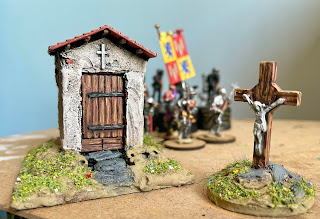Here we have, the 3rd Earl of Northumberland, Henry Percy, and bodyguard
of MAAs and standard bearer. The figures are all Perry’s, except for the the standard
bearer, one of my few remaining Essexes. All straight from the box, awaiting bases.
Percy, who led the right wing of the Lancastrians at Towton,
was killed in the battle.
The two figures with coats of arms are:
- Sir Edward Gascoigne, of Parlington, Yorkshire. His heraldry
is Argent, on a pale Sable a lucy’s head erect and couped Or. I’m not sure if there is a nod to his Percy
lord’s own use of (three) lucys in his arms.
And,
- Sir John Pennington, (c.1393-1470) of Muncaster in Cumberland.
His arms are, according to Freezewater's list - Or 5 fusils in fess Azure a label of 5 points Gules.
Pennington seems to have had a full life, as recorded in
The
History of Parliament’s blog,
in its excellent studies of
those
parliamentarians who fought at the Battle of Agincourt.
He came from “one of the richest and most
ancient of the gentry families of the north-west”. After fighting at Agincourt,
he left the French campaigns in 1422, following Henry V’s death. He was a
member of the 1432 Parliament, though this seems to have been a brief career
choice. His main focus was local politics of a more muscular and typical kind.
He was involved in the Percy’s strong-arm activities in the north.
“In 1443 he took up arms in the Earl of
Northumberland’s dispute with John Kemp, archbishop of York, over conflicting
spheres of influence in Yorkshire. More significantly, on 23 October 1448 he
was one of the leaders of a raiding force into Scotland commanded by the earl’s
eldest son, Henry Percy, Lord Poynings, which suffered a defeat, both
unexpected and humbling, by the Scots at the river Sark. Later, as the rivalry
between the Percys and their great local rivals, the Nevilles, became
dangerously intense, he again took up arms. On 10 August 1453 he was singled
out by the Crown as a ‘greet sturrer and moever’ of riots in the north and
ordered to obey royal commissioners. Two weeks later, entirely unabashed by
this royal order, he was in the Percy army which confronted the Nevilles at
Heworth Moor near York. Thereafter his fortunes fluctuated with those of the
two great rival families, which in turned mirrored those of York and Lancaster
as the Nevilles committed themselves to the former and the Percys to the
latter.”
The House of Parliament blog says that despite there being little evidence, “it
is likely that, despite his advanced years, he was in the Percy retinue at the
battles of St. Albans in May 1455, at Wakefield in December 1460 and at Towton
in March 1461.” The Battle of Towton and Freezewater lists, possibly circular
in their evidence, place him at Towton.
The Parliament blog also says there is a family legend that Pennington hosted
Henry VI on his flight from Towton.
“According to a lost monumental inscription in
the church of Muncaster, Henry VI came to Muncaster in 1461 and gave Sir John,
‘a brauve workyd Glasse Cuppe’, which, if the family kept it unbroken, would
ensure that their affairs thrived, ‘whyche Cuppe is Kalled the lucke of
Molcastre’. Unfortunately the inscription was not contemporary and contained
clear errors. None the less, there is nothing intrinsically unlikely about the
defeated Henry VI having come to Muncaster either after Towton or else after the
later Lancastrian defeat at Hexham in 1464.”
The Muncaster
Castle website suggests, however, that Henry VI was sheltered by Pennington
after Hexham rather than Towton.
Despite his Percy affinity, Sir John was not forfeited at any time. He may have been pardoned in 1462. However, “William,
either Sir John’s son or grandson, was among the Lancastrians executed after
capture at the battle of Hexham. Sir
John lived long enough for the restoration of the Percy earl in March 1470 but
died three months later.”
I’ve also managed to complete two religious structures. The
cross is a from a religious pendent. I’ve a few more of these to use.
The chapel started off as a chalet load for a Majorette Saviem,
bought on holiday many moons ago. One a bit like this, if only I had realised
the price these go for on eBay, I may not have got the saw and glue out.
I miss French toy shops of old, with Majorettes trucks and
Starlux plastic soldiers.
Anyway, cribbing an idea from Painterman
and John
Boadle’s somewhat more impressive examples, it’s a plastic card build around
the shell of the chalet, leaving the roof and windows exposed, then a render, a
spare box door, and dry brushing and lots of washes until it had the lived-in-look
I wanted.
I did make it for my WoRs project, but its hard to find
images of medieval British chapels and shrines, Henry – VIII and Cromell –
Oliver, put pay to them. Its far easier to find extant ones and images for
continental ones. If you haven’t already come across it, the illustrations in
the Luzern Chronicles
illustrated by Schilling are a great inspiration for virtually anything late-C15th / early-C16th for everyday life items, from churches and castles to target shotting with handguns, glass work, ships, foodstuffs and baggage.








.jpeg)


























.jpeg)
.jpeg)
.jpeg)



